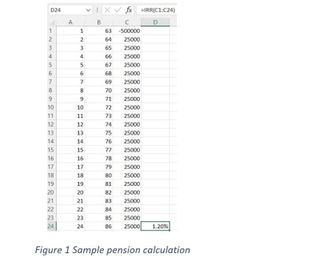Should You Take Pension Payments or a Lump Sum? A How-To Guide
With buyout offers, when deciding whether to take it or leave it, a couple of calculations can be enlightening. This how-to guide walks you through the steps to help make the right choice for you.


Your employer doesn’t want to be in the pension business. It’s too expensive. Low interest rates force employers to beef up their pension contributions or invest in riskier assets to meet their plans’ assumed rates of returns.
For this reason, employers offer lump-sum buyouts. The company wants you to take the buyout so they can exit the pension business and save money. You can take the pension lump sum and roll it tax-free into an IRA.
But how do you evaluate a one-time lump-sum offer against the possibility of lifetime payments that a pension offers?

Sign up for Kiplinger’s Free E-Newsletters
Profit and prosper with the best of expert advice on investing, taxes, retirement, personal finance and more - straight to your e-mail.
Profit and prosper with the best of expert advice - straight to your e-mail.
Should you take it or leave it? Here is one approach I use when evaluating a client’s pension offer:
Step 1. Run the numbers
Start by calculating the internal rate of return (IRR) of the pension. The IRR tells you the rate of return you would need to beat by investing your lump sum in order for it to make sense to take one. Here are the steps in Excel:
- In Column A enter the year in every row, 1-30 for example. In Column B enter your age in every row till life expectancy. See Figure 1.
- In Column C, enter the lump sum as a negative number in the year the lump sum is paid out. Don’t worry, it’s only negative because that’s representing a cash outflow.
- Below the lump sum value in Column C, copy and paste the annual pension payout into every row for each year you live, till your life expectancy used in step 1.
- In Column D, at your life expectancy, enter this formula: =IRR(C1:C24) and then press Enter. If the answer that appears is a whole number, chances are you need to allow for a few more decimal places. Right click on the cell, click on “Format Cells” and then set your decimal places to two places.
- If all else fails, there are many free online IRR calculators. Remember to enter the lump sum as a negative cash flow and the pension payout as positive cash flow. Use the joint life payout if you are married and the straight life if you are single.
To see how this all works, let’s look at an example. In Figure 1, I compare a lump-sum offer of $500K to the 100% joint survivor pension option, which is $25K a year. Single investors use the single-life pension payout. The formula in this case results in an internal rate of return of 1.20%.
What does this IRR of 1.2% mean? It means that if you lived to age 86, then you’d have to generate a return of 1.2% on your lump sum each year in order to match what your pension would pay over the course of that same time period.

To see the IRR at different life expectancies, try typing the formula in Column D into different rows. Be sure the cell range in the IRR formula always starts with the lump-sum cell in Column C and ends with the age you want. For example, =IRR(C1:C18) would be the formula used at age 80 in Column D.
The longer you live, the greater the return your pension would be delivering — and the higher the return you’d need to generate on your own with your lump sum to match it. This makes sense, because you are getting more money returned to you over time with your pension payments. In my example, the true IRR is a little higher since we technically can’t take the lump-sum till 65, not 64, but the way we set it up here makes it easier for you to view.
Two more ways to do the math: Another approach is to figure the Pension Income Ratio (PIR). The PIR is the annual withdraw divided by the lump sum. A PIR greater than 5% may be hard to replicate in an IRA.
Finally, know the break-even point. If you took the pension option, how long would it take to get the full lump sum amount? In this example, at $25K a year it takes 20 years to get back the $500K lump sum amount. Twenty years for a 65-year-old is a long time to wait to get all your money.
Step 2. Ask yourself: Can I beat the payout?
In our example, at age 86, the return is 1.20%. With that low of a return, I’d rather take the lump-sum and invest in a diversified portfolio of stocks and bonds. This is the case with most pensions I review.
Some retirees are more conservative. Conservative investors may not trust the stock market. Others may feel they have enough assets at risk with their 401(k) and they may not want to take risk with the pension. Those investors put a higher value on the annual pension income stream and may not want to try to beat the IRR of the pension.
Step 3. Analyze the trade-offs
Loss of purchasing power
In my opinion, taking the traditional joint and survivor pension income only looks good in year one, then loses its luster, because after that, inflation takes hold. Pension income is typically level: You steadily lose purchasing power over time as prices increase. In our example, the $25K of pension income in year one is roughly worth only $15K in 25 years, assuming a 2% inflation rate. The loss of purchasing power is an important trade-off to understand. Your future self may regret taking the annual pension payout if it doesn’t keep up with your standard of living.
On the other hand, your spending may decrease later in life. If you are less active, you may need less income. (Unless a severe health event like long-term care is needed, which is a large expense.) If you have other assets growing in the stock market that can make up for the loss in pension purchasing power that helps too. Some pensions provide inflation-adjusted income, which is highly valuable.
No access to principal
If you elect to take the pension income, you can’t take more or less money in any given year. If you take the lump sum, you can. If you elect to take the lump sum you can skip a withdraw or take out more for a vacation or an emergency. You have more control over a lump sum.
Of course, more control can mean more trouble. Will you use the lump sum to buy a boat, a lavish vacation each year, or simply spend it all too soon? As Shakespeare wrote, “To thine own self be true.” You must be honest with yourself. Spendthrifts may be better off taking the pension or buying an annuity with the lump sum if it helps with monthly budgeting. A financial adviser can help too. Having an arm’s length relationship with your money may be all you need to prevent you using the lump sum as an ATM.
No inheritance
The final trade-off is how much do you value leaving the pension asset to your family? Most retirees I speak with think it is important, but it is not the sole driver in their decision making. Still, just about everyone I speak with agrees it is a tragedy if Mom and Dad pass at the same time in the proverbial plane crash three years into retirement, leaving the kids nothing because the pension income stops. At least with moving the lump sum to an IRA your kids can inherit the balance.
Another solution is pension maximization. Pension maximization is buying life insurance with the straight-life pension payout. The straight-life pension payout provides the most income, but the income stops at death. Pension maximization uses the extra payments from the straight-life pension to buy life insurance. The life insurance death benefit “replaces” the lost pension income at death. The math works best for those who are younger and healthy, because life insurance rates are based on age and health history.
Pension income has merits — don’t get me wrong. Studies have shown retirees who have a guaranteed source of income in retirement report less worry and greater retirement satisfaction. However, you must understand the math in Figure 1 and the trade-offs listed above to make a wise decision.
Which is the better choice?
It really depends on your situation and the pension numbers. Figure 2 is a helpful way to get you started:
Figure 2: To thine own self be true
| Circle one item in Column A or B that identifies you. | Row 0 - Cell 1 |
| Column A | Column B |
| I value access to principal | I value certainty of income |
| I want to leave something to the kids | The kids are fine, or they are getting enough elsewhere. |
| I value the potential growth on the IRA, understanding losses may be incurred along the way. | I am not OK with risk taking in retirement. It makes me uncomfortable to see my account balance go down. |
| I value the ability to take more income in good years of the stock market, knowing I should take less if the account goes down. | I value guaranteed income regardless of what the stock and bond markets do. |
| The pension is a small amount relative to my net worth. | The pension is all I have. |
| I have other sources of reliable income (rents, royalties, spouse’s pension) | I have no or very little guaranteed income in retirement. |
| I generally am OK with taking risk, knowing I may get rewarded. | I am as conservative investor as they come! |
If you circled more in Column B than Column A, you value the pension income over investing the lump sum. That is OK, there is no right or wrong decision, this is a personal choice! If you circled more in Column A, then you are comfortable with risk and probably already have a diversified portfolio in the stock market. Column A people should consider taking the lump-sum option and build out an investment portfolio that will hopefully outlast them.
If you are somewhere in between Column A and Column B, then you might want to evaluate using the lump sum to purchase an annuity in an IRA. Certain annuities provide a steady monthly income stream that may mirror the pension payout, but still allow for access to principal. That’s a win-win, for those who value guaranteed income but still want to leave the balance to the kids. There is much more to consider on whether an annuity strategy is right for you. I encourage you to speak to a qualified, independent financial planner.
Final thoughts
The decision on how to take a pension — straight life, joint payout or lump-sum — is not easy. Each pension, like each person’s situation, is unique. And the choice you make you are stuck with. It is irrevocable, affecting your retirement and your spouse’s. No pressure!
Given the weight of the decision, in my opinion, the decision on whether to take a pension or a lump sum requires a careful and thorough analysis of the various trade-offs, risks and opportunities. I suggest seeking guidance from an independent financial adviser who has fiduciary responsibility to you and is experienced in this field. Call me if you need me.
For help in analyzing your pension options email me or subscribe to my blog for more retirement planning insights.
Disclaimer
Investment advisory and financial planning services are offered through Summit Financial LLC, an SEC Registered Investment Adviser, 4 Campus Drive, Parsippany, NJ 07054. Tel. 973-285-3600 Fax. 973-285-3666. This material is for your information and guidance and is not intended as legal or tax advice. Clients should make all decisions regarding the tax and legal implications of their investments and plans after consulting with their independent tax or legal advisers. Individual investor portfolios must be constructed based on the individual’s financial resources, investment goals, risk tolerance, investment time horizon, tax situation and other relevant factors. Past performance is not a guarantee of future results. The views and opinions expressed in this article are solely those of the author and should not be attributed to Summit Financial LLC. Links to third-party websites are provided for your convenience and informational purposes only. Summit is not responsible for the information contained on third-party websites. The Summit financial planning design team admitted attorneys and/or CPAs, who act exclusively in a non-representative capacity with respect to Summit’s clients. Neither they nor Summit provide tax or legal advice to clients. Any tax statements contained herein were not intended or written to be used, and cannot be used, for the purpose of avoiding U.S. federal, state or local taxes.
Get Kiplinger Today newsletter — free
Profit and prosper with the best of Kiplinger's advice on investing, taxes, retirement, personal finance and much more. Delivered daily. Enter your email in the box and click Sign Me Up.

Michael Aloi is a CERTIFIED FINANCIAL PLANNER™ Practitioner and Accredited Wealth Management Advisor℠ with Summit Financial, LLC. With 21 years of experience, Michael specializes in working with executives, professionals and retirees. Since he joined Summit Financial, LLC, Michael has built a process that emphasizes the integration of various facets of financial planning. Supported by a team of in-house estate and income tax specialists, Michael offers his clients coordinated solutions to scattered problems.
-
 RMD Deadline April 1: Five Tax Strategies to Manage Your 2025 Income
RMD Deadline April 1: Five Tax Strategies to Manage Your 2025 IncomeTaxable Income The April 1, 2025, deadline for required minimum distributions (RMDs) is fast approaching for retirees who turned 73 in 2024.
By Kelley R. Taylor Published
-
 Rising AI Demand Stokes Undersea Investments
Rising AI Demand Stokes Undersea InvestmentsThe Kiplinger Letter As demand soars for AI, there’s a need to transport huge amounts of data across oceans. Tech giants have big plans for new submarine cables, including the longest ever.
By John Miley Published
-
 The Three Biggest Fears Keeping Retirees Up at Night
The Three Biggest Fears Keeping Retirees Up at NightHere are the steps you can take to put those fears to rest and retire with confidence so you can relax and enjoy the life you've planned.
By Pam Krueger Published
-
 What Can a Donor-Advised Fund Do for You? (A Lot)
What Can a Donor-Advised Fund Do for You? (A Lot)DAFs and private foundations go about helping charities (and those who donate) in different ways. Each comes with its own benefits and restrictions to navigate.
By Julia Chu Published
-
 Estate Planning When You Have International Assets
Estate Planning When You Have International AssetsEstate planning gets tricky when you have assets and/or beneficiaries outside the U.S. To avoid costly inheritance mistakes, it pays to understand the basics.
By Kelsey M. Simasko, Esq. Published
-
 Three Essential Estate Planning Steps to Protect Your Nest Egg
Three Essential Estate Planning Steps to Protect Your Nest EggAfter dedicating years to building your wealth and securing your future, make sure your assets are protected and your loved ones are provided for in the future.
By Nicole Farbo, CFP® Published
-
 Is Chasing the American Dream Ruining Your Financial Life?
Is Chasing the American Dream Ruining Your Financial Life?Too many people focus on visible affluence as a marker of success. Here's how to avoid succumbing to the pressure and driving yourself into debt.
By Anthony Martin Published
-
 Retiring With a Pension? Four Things to Know
Retiring With a Pension? Four Things to KnowThe road to a secure retirement is slightly more intricate for people with pensions. Here are four key issues to consider to make the most out of yours.
By Joe F. Schmitz Jr., CFP®, ChFC® Published
-
 How to Teach Your Kids About the Tax Facts of Life
How to Teach Your Kids About the Tax Facts of LifeTaxes are unavoidable, so it's important to teach children what to expect. Also, does your child need to file a tax return for 2024? Find out here.
By Neale Godfrey, Financial Literacy Expert Published
-
 Revocable Living Trusts: The Good, the Bad and the Ugly
Revocable Living Trusts: The Good, the Bad and the UglyPeople are conditioned to believe they should avoid probate at all costs, but when compared with living trusts, probate could be a smart choice for some folks.
By Charles A. Borek, JD, MBA, CPA Published